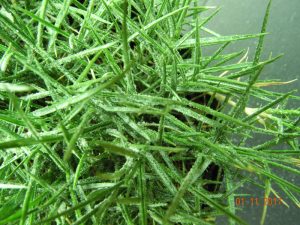The zoysiagrass solution for salinity
November 22, 2017 | Milt Engelke, Ph.D.
Zoysiagrass is different from other salt-tolerant species. Discover the science behind how this game-changing grass thrives in salt-heavy soils.
With zoysiagrass, salts are absorbed by the roots, are moved into the plant without tissue injury, and accumulate on the leaf surface through the biological characteristic of having very active salt glands — a characteristic unique to zoysiagrass. Photos courtesy of Team Zoysia.
The Paspalum problem
The science behind dealing with salinity has been somewhat heavily skewed toward containment or mechanically moving excessive salts through the soil profile through leaching, flushing and/or chemical treatment. Paspalums are known halophytes — they exclude salts from concentration in the leaf tissue to avoid salt tissue injury, and, as such, they can tolerate exceptionally high concentration of salts in the root zone and soil profile, at least up to a point.
Seasonally, nearly every environment will experience prolonged periods of low rainfall and possibly even drought, during which time evaporation of surface waters draws saline-laden moisture to the surface where the salts accumulate. Once salt accumulation reaches a critical level, even the Paspalums will begin to suffer. At this point, the only true resolve is to dramatically increase the level of water application to 1) help resolubilize the accumulated salts, and 2) force downward movement of these salts lower in the soil profile, from which they will rise again and require that the process be repeated, usually on a 15- to 30-day cycle, once to several times during the season. Hearsay suggests that as much as 30 percent of the total water needed for turf maintenance of Paspalum is required for flushing and/or leaching salts.
CLICK TO READ FULL ARTICLE
